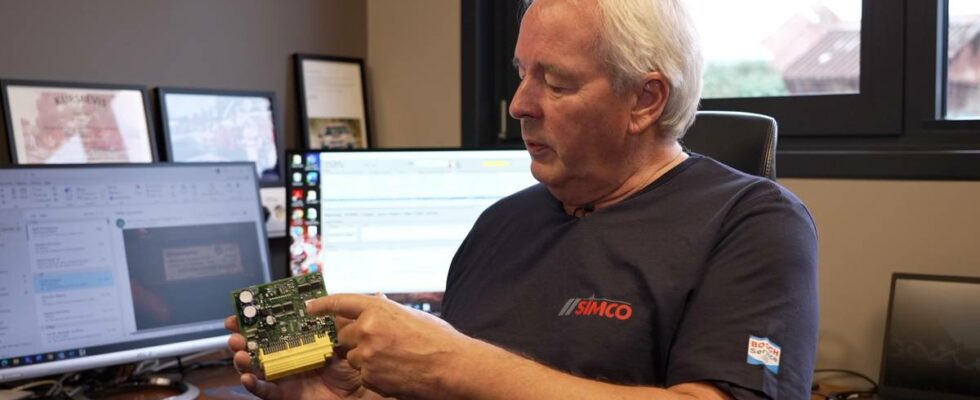On 23 September, a Volvo XC40 drove out from the fourth floor of the Sandvika shopping center car park. A 60-year-old man lost his life in the accident. The car must have driven through guard rails, an iron grid and a solid brick wall. The Volvo has been handed in to the National Roads Administration and the police believe it is most likely a technical failure or user error. Volvo and the Norwegian Public Roads Administration have so far been tight-lipped. But what can the car actually tell us about the accident? The answers are most likely stored in a small black box, which is well hidden in most cars. The Norwegian Road Administration has carried out the physical examination of the car from the Sandvika accident, and will now process and compile this information. Photo: Cornelius Poppe / NTB The black box At the Simco car workshop in Råde, we meet general manager Simen Huse. On several occasions, he has assisted relatives, the police, the Norwegian Road Administration and insurance companies with accident investigations. Huse is also one of Norway’s foremost experts on black boxes. – The information we extract from the black boxes is 100 per cent reliable. The general manager of Simco, Simen Huse, says that the team at Simco often assists with investigations in accidents. Photo: Jan Kenneth Bråten / news As a committed professional, he takes news with him through the workshop, where he eagerly explains how the box works. It records everything from the use of the clutch, speed and brake to the belt, autopilot and lights, explains Huse. – There is probably nothing that is not recorded. The box listens to the car all the time, but it does not save the information until an event occurs. This is the black box. It is usually located under the center console. Photo: Jan Kenneth Bråten / news The information can give a picture of the sequence of events before, during and immediately after an accident. – There are accident sensors located in the bumpers. They report if something unexpected occurs and then a recording begins, says Huse and adds: – Then we can go in and read afterwards what happened. According to Huse, the box cannot break. – The pieces in the box can rarely be destroyed. I have never been exposed to that. Huse shows off the pieces inside the black box. The box was mandated in all new cars in Norway in 2024. Photo: Jan Kenneth Bråten / news There have been investigations into unexpected acceleration The car involved in the fatal accident in Sandvika, a Volvo XC40, was recalled and modified in 2022. Over 5,000 cars of the same model was recalled by Volvo in 2022 due to a defect that could lead to unexpected acceleration. On Wednesday it also became clear that several cars in the Oslo area have been or have been submitted for investigations for technical failure. – We have several traffic accidents now and accidents with serious consequences where the driver says that the car has behaved strangely, says police attorney Kathrine Eilertsen. In these cases, it should be about electric cars, but different car brands and models. – A recurring point is sudden acceleration, says Eilertsen. Police attorney Kathrine Eilertsen says that the police never rule out a technical failure in cars until they have been examined by professionals. Photo: Bård Nafstad / news Concerned about the development Cars that have problems with acceleration are not unknown to Huse either. – We have heard about it and we have had some investigations into it. He emphasizes that the increasing amount of electronics in modern cars also increases the risk of technical errors. – There are more and more electronics on board a vehicle, and therefore more opportunities for margin of error. Simen Huse, general manager of Simco, has worked with the black box for several years before it was mandated in Norway. Photo: Jan Kenneth Bråten / news Does not have the same control as before Jan Moberg, director of technology at Teknisk Ukeblad, shares his concern about the rapid development in car technology. – When we receive so many parallel reports that this has happened to others, there is every possible reason to keep it open that the car may have done this itself. Director of Technology at Teknisk Ukeblad, Jan Moberg, expresses concern about developments in car technology. Photo: Teknisk Ukeblad Moberg believes drivers do not have the same control as before. – Before we pressed the gas pedal, the brake, we put it in gear, we used the clutch and all that, he says and adds: – Now there is a ripping development, where electronics, sensors, processors, mobile networks and software are mixed together. This development makes it more difficult for drivers to understand what is actually happening in the car, Moberg believes. – This information, you could say, is encapsulated in a kind of black box that we don’t have access to. Hello! Do you have any thoughts on the matter, or tips for something else I should look into? Send me an e-mail: [email protected] Published 17.10.2024, at 18.02 Updated 18.10.2024, at 09.10
ttn-69
This is how the car must have stored information about the accident – Stor-Oslo

